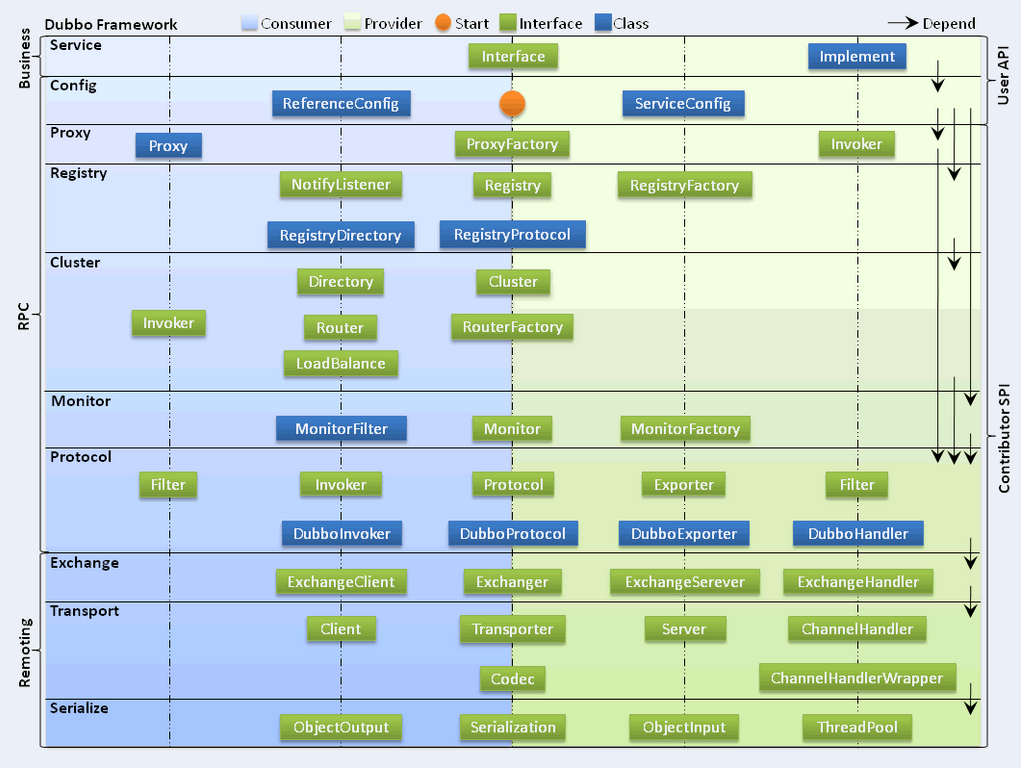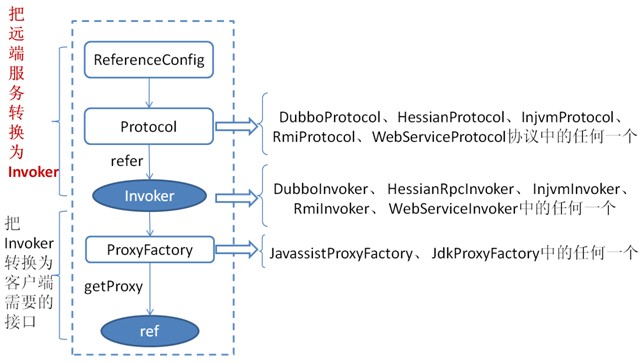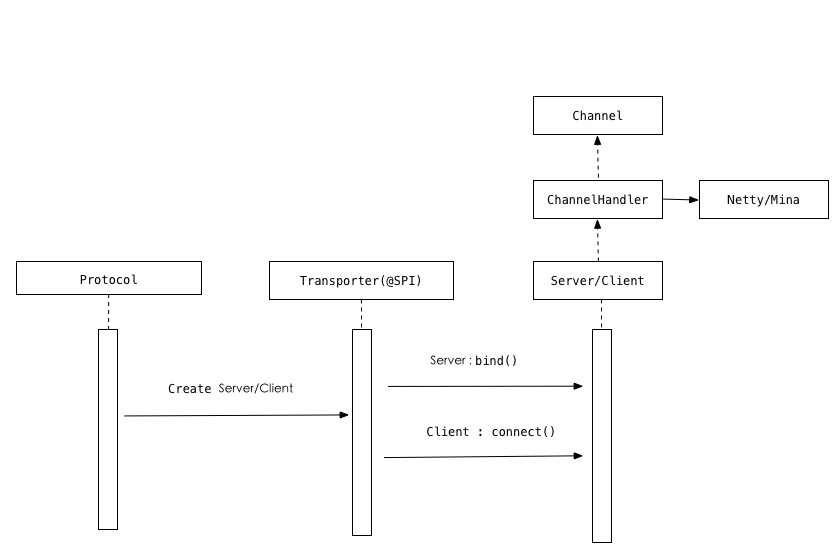Dubbo的实现原理分析
Dubbo的技术框架如下图所示:
DUBBO官方文档中,对于上图中各层的功能描述:
1. config:配置层,对外配置接口,以ServiceConfig,ReferenceConfig为中心,可以直接new配置类,也可以通过spring解析配置生成配置类。
2. proxy:服务代理层,服务接口透明代理,生成服务的客户端Stub和服务器端Skeleton,以ServiceProxy为中心,扩展接口为ProxyFactory。
3. registry:注册中心层,封装服务地址的注册与发现,以服务URL为中心,扩展接口为RegistryFactory,Registry,RegistryService。
4. cluster:路由层,封装多个提供者的路由及负载均衡,并桥接注册中心,以Invoker为中心,扩展接口为Cluster,Directory,Router,LoadBalance。
5. monitor:监控层,RPC调用次数和调用时间监控,以Statistics为中心,扩展接口为MonitorFactory,Monitor,MonitorService 。
6. protocol:远程调用层,封将RPC调用,以Invocation,Result为中心,扩展接口为Protocol, Invoker, Exporter。
7. exchange:信息交换层,封装请求响应模式,同步转异步,以Request, Response为中心,扩展接口为Exchanger,ExchangeChannel,ExchangeClient,ExchangeServer。
8. transport:网络传输层,抽象mina和netty为统一接口,以Message为中心,扩展接口为Channel,Transporter,Client,Server,Codec。
9. serialize:数据序列化层,可复用的一些工具,扩展接口为Serialization,ObjectInput,ObjectOutput,ThreadPool。
2. 服务发布过程
2.1 发布过程
Dubbo利用Spring的解析(或自己实现)收集到很多一些配置,然后将这些配置都存至ServiceConfig中,然后调用ServiceConfig的export()方法来进行服务的发布与注册。
服务的发布过程如下图所示。首先ServiceConfig类拿到对外提供服务的实际类ref(如:HelloWorldImpl),然后通过ProxyFactory类的getInvoker方法使用ref生成一个AbstractProxyInvoker实例,到这一步就完成具体服务到Invoker的转化。接下来就是Invoker转换到Exporter的过程。
Dubbo处理服务暴露的关键就在Invoker转换到Exporter的过程(如下图中的红色部分),Dubbo协议的Invoker转为Exporter发生在DubboProtocol类的export方法,它主要是打开socket侦听服务,并接收客户端发来的各种请求,通讯细节由Dubbo自己实现。
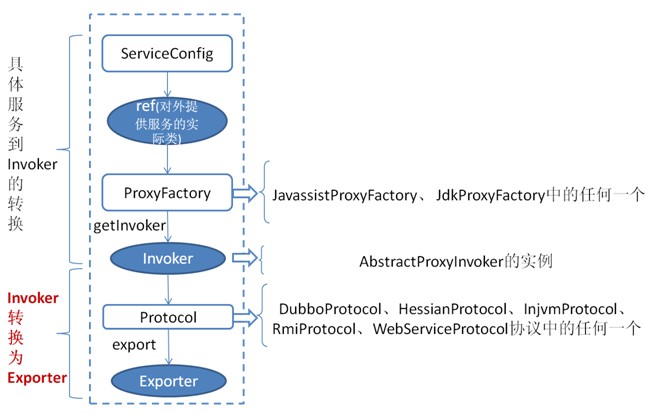
先看一个简单的服务端例子,dubbo配置如下:
<dubbo:application name="helloService-app" />
<dubbo:registry protocol="zookeeper" address="127.0.0.1:2181" />
<dubbo:service interface="com.demo.dubbo.service.HelloService" ref="helloService" />
<bean id="helloService" class="com.demo.dubbo.server.serviceimpl.HelloServiceImpl"/>
有一个服务接口,HelloService,以及它对应的实现类HelloServiceImpl,将HelloService标记为dubbo服务,使用HelloServiceImpl对象来提供具体的服务,使用zooKeeper作为注册中心。则该注册过程的伪代码如下所示:
List<URL> registryURLs = loadRegistries();
for (ProtocolConfig protocolConfig : protocols) {
//根据每一个协议配置构建一个URL
URL url = new URL(name, host, port, (contextPath == null || contextPath.length() == 0 ? "" : contextPath + "/") + path, map);
for (URL registryURL : registryURLs) {
String providerURL = url.toFullString();
Invoker<?> invoker = proxyFactory.getInvoker(ref, (Class) interfaceClass, registryURL.addParameterAndEncoded(RpcConstants.EXPORT_KEY, providerURL));
Exporter<?> exporter = protocol.export(invoker);
}
}
2.2 Invoker
Invoker: 一个可执行的对象,能够根据方法名称、参数得到相应的执行结果。接口内容简略如下:
public interface Invoker<T> {
Class<T> getInterface();
URL getUrl();
Result invoke(Invocation invocation) throws RpcException;
void destroy();
}
而Invocation则包含了需要执行的方法、参数等信息,接口定义简略如下:
public interface Invocation {
URL getUrl();
String getMethodName();
Class<?>[] getParameterTypes();
Object[] getArguments();
}
目前其实现类只有一个RpcInvocation,仅仅提供了Invocation所需要的参数而已。内容大致如下:
public class RpcInvocation implements Invocation, Serializable {
private String methodName;
private Class<?>[] parameterTypes;
private Object[] arguments;
private transient URL url;
}
Invoker可执行对象的执行过程分成三种类型:
类型1:本地执行类的Invoker
类型2:远程通信执行类的Invoker
类型3:多个类型2的Invoker聚合成的集群版的Invoker
以HelloService接口方法为例:
1. 本地执行类的Invoker: server端,含有对应的HelloServiceImpl实现,要执行该接口方法,仅仅只需要通过反射执行HelloServiceImpl对应的方法即可
2. 远程通信执行类的Invoker: client端,要想执行该接口方法,需要需要进行远程通信,发送要执行的参数信息给server端,server端利用上述本地执行的Invoker执行相应的方法,然后将返回的结果发送给client端。这整个过程算是该类Invoker的典型的执行过程
3. 集群版的Invoker:client端,拥有某个服务的多个Invoker,此时client端需要做的就是将这个多个Invoker聚合成一个集群版的Invoker,client端使用的时候,仅仅通过集群版的Invoker来进行操作。集群版的Invoker会从众多的远程通信类型的Invoker中选择一个来执行(从中加入负载均衡策略),还可以采用一些失败转移策略等。
2.3 ProxyFactory
proxy代理层按照DUBBO官方文档的解释,是用来生成RPC调用的Stub和Skeleton,这样做的目的是让您在DUBBO服务端定义的具体业务实现不需要关心“它将被怎样调用”,也是您定义的服务接口“与RPC框架脱耦”。
对于server端,ProxyFactory主要负责将服务如HelloServiceImpl统一进行包装成一个Invoker,这些Invoker通过反射来执行具体的HelloServiceImpl对象的方法。接口定义如下:
@Extension("javassist")
public interface ProxyFactory {
//针对client端,创建出代理对象
@Adaptive({Constants.PROXY_KEY})
<T> T getProxy(Invoker<T> invoker) throws RpcException;
//针对server端,将服务对象如HelloServiceImpl包装成一个Invoker对象
@Adaptive({Constants.PROXY_KEY})
<T> Invoker<T> getInvoker(T proxy, Class<T> type, URL url) throws RpcException;
}
ProxyFactory的接口实现有JdkProxyFactory、JavassistProxyFactory,默认是JavassistProxyFactory,JdkProxyFactory内容如下:
public <T> Invoker<T> getInvoker(T proxy, Class<T> type, URL url) {
return new AbstractProxyInvoker<T>(proxy, type, url) {
@Override
protected Object doInvoke(T proxy, String methodName,
Class<?>[] parameterTypes,
Object[] arguments) throws Throwable {
Method method = proxy.getClass().getMethod(methodName, parameterTypes);
return method.invoke(proxy, arguments);
}
};
}
可以看到是创建了一个AbstractProxyInvoker(这类就是本地执行的Invoker),它对Invoker的Result invoke(Invocation invocation)实现如下:
public Result invoke(Invocation invocation) throws RpcException {
try {
return new RpcResult(doInvoke(proxy, invocation.getMethodName(), invocation.getParameterTypes(), invocation.getArguments()));
} catch (InvocationTargetException e) {
return new RpcResult(e.getTargetException());
} catch (Throwable e) {
throw new RpcException("Failed to invoke remote proxy " + invocation + " to " + getUrl() + ", cause: " + e.getMessage(), e);
}
}
2.4 Protocol
从上面得知服务发布的第一个过程就是:使用ProxyFactory将HelloServiceImpl封装成一个本地执行的Invoker。
执行这个服务,即执行这个本地Invoker,即调用这个本地Invoker的invoke(Invocation invocation)方法,方法的执行过程就是通过反射执行了HelloServiceImpl的内容。现在的问题是:这个方法的参数Invocation invocation的来源问题。
针对server端来说,Protocol要解决的问题就是:根据指定协议对外公布这个HelloService服务,当客户端根据协议调用这个服务时,将客户端传递过来的Invocation参数交给上述的Invoker来执行。所以Protocol加入了远程通信协议的这一块,根据客户端的请求来获取参数Invocation invocation。
先来看下Protocol的接口定义:
@Extension("dubbo")
public interface Protocol {
int getDefaultPort();
//针对server端来说,将本地执行类的Invoker通过协议暴漏给外部。这样外部就可以通过协议发送执行参数Invocation,然后交给本地Invoker来执行
@Adaptive
<T> Exporter<T> export(Invoker<T> invoker) throws RpcException;
//这个是针对客户端的,客户端从注册中心获取服务器端发布的服务信息
//通过服务信息得知服务器端使用的协议,然后客户端仍然使用该协议构造一个Invoker。这个Invoker是远程通信类的Invoker。
//执行时,需要将执行信息通过指定协议发送给服务器端,服务器端接收到参数Invocation,然后交给服务器端的本地Invoker来执行
@Adaptive
<T> Invoker<T> refer(Class<T> type, URL url) throws RpcException;
void destroy();
}
我们再来详细看看服务发布的第二步:
- Exporter<?> exporter = protocol.export(invoker);
- Protocol protocol = ExtensionLoader.getExtensionLoader(Protocol.class).getAdaptiveExtension();
最终的Protocol的实现代码:
public com.alibaba.dubbo.rpc.Exporter export(com.alibaba.dubbo.rpc.Invoker arg0) throws com.alibaba.dubbo.rpc.RpcException{
if (arg0 == null) {
throw new IllegalArgumentException("com.alibaba.dubbo.rpc.Invoker argument == null");
}
if (arg0.getUrl() == null) {
throw new IllegalArgumentException("com.alibaba.dubbo.rpc.Invoker argument getUrl() == null");
}
com.alibaba.dubbo.common.URL url = arg0.getUrl();
String extName = ( url.getProtocol() == null ? "dubbo" : url.getProtocol() );
if(extName == null) {
throw new IllegalStateException("Fail to get extension(com.alibaba.dubbo.rpc.Protocol) name from url(" + url.toString() + ") use keys([protocol])");
}
com.alibaba.dubbo.rpc.Protocol extension = (com.alibaba.dubbo.rpc.Protocol)com.alibaba.dubbo.common.ExtensionLoader.getExtensionLoader(com.alibaba.dubbo.rpc.Protocol.class).getExtension(extName);
return extension.export(arg0);
}
public com.alibaba.dubbo.rpc.Invoker refer(java.lang.Class arg0,com.alibaba.dubbo.common.URL arg1) throws com.alibaba.dubbo.rpc.RpcException{
if (arg1 == null) {
throw new IllegalArgumentException("url == null");
}
com.alibaba.dubbo.common.URL url = arg1;
String extName = ( url.getProtocol() == null ? "dubbo" : url.getProtocol() );
if(extName == null) {
throw new IllegalStateException("Fail to get extension(com.alibaba.dubbo.rpc.Protocol) name from url(" + url.toString() + ") use keys([protocol])");
}
com.alibaba.dubbo.rpc.Protocol extension = (com.alibaba.dubbo.rpc.Protocol)com.alibaba.dubbo.common.ExtensionLoader.getExtensionLoader(com.alibaba.dubbo.rpc.Protocol.class).getExtension(extName);
return extension.refer(arg0, arg1);
}
使用装饰器模式,类似AOP的功能。
下面主要讲解RegistryProtocol和DubboProtocol,先暂时忽略ProtocolFilterWrapper、ProtocolListenerWrapper
所以上述服务发布的过程
export(Invoker invoker)的过程即根据Invoker中url的配置信息来最终选择Protocol的实现,默认实现是"dubbo"的扩展实现即DubboProtocol,然后再对DubboProtocol进行依赖注入,进行wrap包装。
这里写图片描述
可以看到在返回DubboProtocol之前,经过了ProtocolFilterWrapper、ProtocolListenerWrapper、RegistryProtocol的包装。
所谓的包装就是如下类似的内容:
[java] view plain copy
package com.alibaba.xxx;
import com.alibaba.dubbo.rpc.Protocol;
public class XxxProtocolWrapper implemenets Protocol {
Protocol impl;
public XxxProtocol(Protocol protocol) { impl = protocol; }
// 接口方法做一个操作后,再调用extension的方法
public Exporter<T> export(final Invoker<T> invoker) {
//... 一些操作
impl .export(invoker);
// ... 一些操作
}
// ...
}
- Exporter<?> exporter = protocol.export(invoker);
1. 利用内部的Protocol即DubboProtocol,将服务进行导出,如下
- exporter = protocol.export(new InvokerWrapper<T>(invoker, url));
- Registry registry = registryFactory.getRegistry(registryUrl);
- registry.register(serviceUrl)
1. 首先根据Invoker的url获取ExchangeServer通信对象(负责与客户端的通信模块),以url中的host和port作为key存至Map<String, ExchangeServer> serverMap中。即可以采用全部服务的通信交给这一个ExchangeServer通信对象,也可以某些服务单独使用新的ExchangeServer通信对象。
String key = url.getAddress();
//client 也可以暴露一个只有server可以调用的服务。
boolean isServer = url.getParameter(RpcConstants.IS_SERVER_KEY,true);
if (isServer && ! serverMap.containsKey(key)) {
serverMap.put(key, getServer(url));
}
最后来张dubbo的解释图片:
2. 创建一个DubboExporter,封装invoker。然后根据url的port、path(接口的名称)、版本号、分组号作为key,将DubboExporter存至Map<String, Exporter<?>> exporterMap中
- key = serviceKey(url);
- DubboExporter<T> exporter = new DubboExporter<T>(invoker, key, exporterMap);
- exporterMap.put(key, exporter);
上述每一个ExchangeServer通信对象都绑定了一个ExchangeHandler requestHandler对象,内容简略如下:
private ExchangeHandler requestHandler = new ExchangeHandlerAdapter() {
public Object reply(ExchangeChannel channel, Object message) throws RemotingException {
if (message instanceof Invocation) {
Invocation inv = (Invocation) message;
Invoker<?> invoker = getInvoker(channel, inv);
RpcContext.getContext().setRemoteAddress(channel.getRemoteAddress());
return invoker.invoke(inv);
}
throw new RemotingException(channel, "Unsupported request: " + message == null ? null : (message.getClass().getName() + ": " + message) + ", channel: consumer: " + channel.getRemoteAddress() + " --> provider: " + channel.getLocalAddress());
}
};

2.5 Exporter
Exporter负责维护invoker的生命周期。接口定义如下:
- public interface Exporter<T> {
- Invoker<T> getInvoker();
- void unexport();
- }
3. 服务调用过程
下图是服务消费的主过程:

首先ReferenceConfig类的init方法调用Protocol的refer方法生成Invoker实例(如上图中的红色部分),这是服务消费的关键。接下来把Invoker通过ProxyFactory代理工厂转换为客户端需要的接口(如:HelloWorld)。
对于一个简单的客户端引用服务的例子,dubbo配置如下:
- <dubbo:application name="consumer-of-helloService" />
- <dubbo:registry protocol="zookeeper" address="127.0.0.1:2181" />
- <dubbo:reference id="helloService" interface="com.demo.dubbo.service.HelloService" />
HelloService接口内容如下:
- public interface HelloService {
- public String hello(String msg);
- }
为了在Spring启动的时候,也相应的启动provider发布服务注册服务的过程:又加入了一个和Spring相关联的 ServiceBean,继承了erviceConfig,为了在Spring启动的时候,也相应的启动consumer发现服务的过程:又加入了一个和Spring相关联的 ReferenceBean,继承了ReferenceConfig,利用Spring就做了上述过程,得到相应的配置数据,然后启动相应的服务。如果想剥离Spring,我们就可以手动来创建上述配置对象,通过 ServiceConfig和 ReferenceConfig的API来启动相应的服务。
服务引用过程
将ReferenceConfig.init()中的内容拆成具体的步骤,如下第一步:收集配置参数
从Spring或者手动创建的配置对象中获得收集到的配置参数,举例如下:
- methods=hello,
- timestamp=1443695417847,
- dubbo=2.5.3
- application=consumer-of-helloService
- side=consumer
- pid=7748
- interface=com.demo.dubbo.service.HelloService
如果是单个注册中心,代码如下:
- Protocol refprotocol = ExtensionLoader.getExtensionLoader(Protocol.class).getAdaptiveExtension();
- invoker = refprotocol.refer(interfaceClass, url);
- registry://127.0.0.1:2181/com.alibaba.dubbo.registry.RegistryService?
- application=consumer-of-helloService&
- dubbo=2.5.6&
- pid=8292&
- registry=zookeeper&
- timestamp=1443707173909&
- refer=
- application=consumer-of-helloService&
- dubbo=2.5.6&
- interface=com.demo.dubbo.service.HelloService&
- methods=hello&
- pid=8292&
- side=consumer&
- timestamp=1443707173884&
- ProxyFactory proxyFactory = ExtensionLoader.getExtensionLoader(ProxyFactory.class).getAdaptiveExtension();
- proxyFactory.getProxy(invoker);
3.1 Invoker
Invoker一个可执行对象。这个可执行对象的执行过程分成三种类型:
类型1:本地执行类的Invoker
类型2:远程通信执行类的Invoker
类型3:多个类型2的Invoker聚合成的集群版的Invoker
对于客户端来说,Invoker则应该是远程通信执行类的Invoker、多个远程通信类型的Invoker聚合成的集群版的Invoker这两种类型。先来说说非集群版的Invoker,即远程通信类型的Invoker。来看下DubboInvoker的具体实现
protected Result doInvoke(final Invocation invocation) throws Throwable {
RpcInvocation inv = (RpcInvocation) invocation;
final String methodName = RpcUtils.getMethodName(invocation);
inv.setAttachment(Constants.PATH_KEY, getUrl().getPath());
inv.setAttachment(Constants.VERSION_KEY, version);
ExchangeClient currentClient;
if (clients.length == 1) {
currentClient = clients[0];
} else {
currentClient = clients[index.getAndIncrement() % clients.length];
}
try {
boolean isAsync = RpcUtils.isAsync(getUrl(), invocation);
boolean isOneway = RpcUtils.isOneway(getUrl(), invocation);
int timeout = getUrl().getMethodParameter(methodName, Constants.TIMEOUT_KEY,Constants.DEFAULT_TIMEOUT);
if (isOneway) {
boolean isSent = getUrl().getMethodParameter(methodName, Constants.SENT_KEY, false);
currentClient.send(inv, isSent);
RpcContext.getContext().setFuture(null);
return new RpcResult();
} else if (isAsync) {
ResponseFuture future = currentClient.request(inv, timeout) ;
RpcContext.getContext().setFuture(new FutureAdapter<Object>(future));
return new RpcResult();
} else {
RpcContext.getContext().setFuture(null);
return (Result) currentClient.request(inv, timeout).get();
}
} catch (TimeoutException e) {
throw new RpcException(RpcException.TIMEOUT_EXCEPTION, "Invoke remote method timeout. method: " + invocation.getMethodName() + ", provider: " + getUrl() + ", cause: " + e.getMessage(), e);
} catch (RemotingException e) {
throw new RpcException(RpcException.NETWORK_EXCEPTION, "Failed to invoke remote method: " + invocation.getMethodName() + ", provider: " + getUrl() + ", cause: " + e.getMessage(), e);
}
}
大概内容就是:
将通过远程通信将Invocation信息传递给服务器端,服务器端接收到该Invocation信息后,找到对应的本地Invoker,然后通过反射执行相应的方法,将方法的返回值再通过远程通信将结果传递给客户端。
这里分成3种情况:
1. 执行的方法不需要返回值:直接使用ExchangeClient的send方法
2. 执行的方法的结果需要异步返回:使用ExchangeClient的request方法,返回一个ResponseFuture,通过ThreadLocal方式与当前线程绑定,未等服务器端响应结果就直接返回
3. 执行的方法的结果需要同步返回:使用ExchangeClient的request方法,返回一个ResponseFuture,一直阻塞到服务器端返回响应结果
3.2 Protocol
从上面得知服务引用的第二个过程就是- invoker = refprotocol.refer(interfaceClass, url);
- Exporter<?> exporter = protocol.export(invoker);
而针对客户端,则需要根据服务器开放的协议(服务器端在注册中心注册的url地址中含有该信息)来创建相应的协议的Invoker对象,如:DubboInvoker、InjvmInvoker和ThriftInvoker等。
如服务器端在注册中心中注册的url地址为:
dubbo://192.168.1.104:20880/com.demo.dubbo.service.HelloService?
anyhost=true&
application=helloService-app&dubbo=2.5.3&
interface=com.demo.dubbo.service.HelloService&
methods=hello&
pid=3904&
side=provider&
timestamp=1444003718316
会看到上述服务是以dubbo协议注册的,所以这里产生的Invoker就是DubboInvoker。我们来具体的看下这个过程
先来看下Protocol的接口定义:
@Extension("dubbo")
public interface Protocol {
int getDefaultPort();
//针对server端来说,将本地执行类的Invoker通过协议暴漏给外部。这样外部就可以通过协议发送执行参数Invocation,然后交给本地Invoker来执行
@Adaptive
<T> Exporter<T> export(Invoker<T> invoker) throws RpcException;
//这个是针对客户端的,客户端从注册中心获取服务器端发布的服务信息
//通过服务信息得知服务器端使用的协议,然后客户端仍然使用该协议构造一个Invoker。这个Invoker是远程通信类的Invoker。
//执行时,需要将执行信息通过指定协议发送给服务器端,服务器端接收到参数Invocation,然后交给服务器端的本地Invoker来执行
@Adaptive
<T> Invoker<T> refer(Class<T> type, URL url) throws RpcException;
void destroy();
}
详细看看服务引用的第二步:
- invoker = refprotocol.refer(interfaceClass, url);
- Protocol protocol = ExtensionLoader.getExtensionLoader(Protocol.class).getAdaptiveExtension();
Protocol的实现代码:
public com.alibaba.dubbo.rpc.Exporter export(com.alibaba.dubbo.rpc.Invoker arg0) throws com.alibaba.dubbo.rpc.RpcException{
if (arg0 == null) {
throw new IllegalArgumentException("com.alibaba.dubbo.rpc.Invoker argument == null");
}
if (arg0.getUrl() == null) {
throw new IllegalArgumentException("com.alibaba.dubbo.rpc.Invoker argument getUrl() == null");
}
com.alibaba.dubbo.common.URL url = arg0.getUrl();
String extName = ( url.getProtocol() == null ? "dubbo" : url.getProtocol() );
if(extName == null) {
throw new IllegalStateException("Fail to get extension(com.alibaba.dubbo.rpc.Protocol) name from url(" + url.toString() + ") use keys([protocol])");
}
com.alibaba.dubbo.rpc.Protocol extension = (com.alibaba.dubbo.rpc.Protocol)com.alibaba.dubbo.common.ExtensionLoader.getExtensionLoader(com.alibaba.dubbo.rpc.Protocol.class).getExtension(extName);
return extension.export(arg0);
}
public com.alibaba.dubbo.rpc.Invoker refer(java.lang.Class arg0,com.alibaba.dubbo.common.URL arg1) throws com.alibaba.dubbo.rpc.RpcException{
if (arg1 == null) {
throw new IllegalArgumentException("url == null");
}
com.alibaba.dubbo.common.URL url = arg1;
String extName = ( url.getProtocol() == null ? "dubbo" : url.getProtocol() );
if(extName == null) {
throw new IllegalStateException("Fail to get extension(com.alibaba.dubbo.rpc.Protocol) name from url(" + url.toString() + ") use keys([protocol])");
}
com.alibaba.dubbo.rpc.Protocol extension = (com.alibaba.dubbo.rpc.Protocol)com.alibaba.dubbo.common.ExtensionLoader.getExtensionLoader(com.alibaba.dubbo.rpc.Protocol.class).getExtension(extName);
return extension.refer(arg0, arg1);
}
refer(interfaceClass, url)的过程即根据url的配置信息来最终选择的Protocol实现,默认实现是"dubbo"的扩展实现即DubboProtocol,然后再对DubboProtocol进行依赖注入,进行wrap包装。先来看看Protocol的实现情况:
可以看到在返回DubboProtocol之前,经过了ProtocolFilterWrapper、ProtocolListenerWrapper、RegistryProtocol的包装。所谓的包装就是如下类似的内容:
package com.alibaba.xxx;
import com.alibaba.dubbo.rpc.Protocol;
public class XxxProtocolWrapper implemenets Protocol {
Protocol impl;
public XxxProtocol(Protocol protocol) { impl = protocol; }
// 接口方法做一个操作后,再调用extension的方法
public Exporter<T> export(final Invoker<T> invoker) {
//... 一些操作
impl .export(invoker);
// ... 一些操作
}
// ...
}
- invoker = refprotocol.refer(interfaceClass, urls.get(0));
1. 根据注册中心的registryUrl获取注册服务Registry,将自身的consumer信息注册到注册中心上
- //先根据客户端的注册中心配置找到对应注册服务
- Registry registry = registryFactory.getRegistry(url);
- //使用注册服务将客户端的信息注册到注册中心上
- registry.register(subscribeUrl.addParameters(Constants.CATEGORY_KEY, Constants.CONSUMERS_CATEGORY,
- Constants.CHECK_KEY, String.valueOf(false)));
- consumer://192.168.1.104/com.demo.dubbo.service.HelloService?
- application=consumer-of-helloService&
- dubbo=2.5.3&
- interface=com.demo.dubbo.service.HelloService&
- methods=hello&
- pid=6444&
- side=consumer&
- timestamp=1444606047076
2. 创建一个RegistryDirectory,从注册中心中订阅自己引用的服务,将订阅到的url在RegistryDirectory内部转换成Invoker
- RegistryDirectory<T> directory = new RegistryDirectory<T>(type, url);
- directory.setRegistry(registry);
- directory.setProtocol(protocol);
- directory.subscribe(subscribeUrl.addParameter(Constants.CATEGORY_KEY,
- Constants.PROVIDERS_CATEGORY
- + "," + Constants.CONFIGURATORS_CATEGORY
- + "," + Constants.ROUTERS_CATEGORY));
RegistryDirectory内部含有两者重要属性:
- 1. 注册中心服务Registry registry
- 2. Protocol protocol。
3. 然后使用 Cluster cluster对象将上述多个Invoker对象(此时还没有真正创建出来,异步订阅,订阅成功之后,回调时才会创建出Invoker)聚合成一个 集群版的Invoker对象。
- @SPI(FailoverCluster.NAME)
- public interface Cluster {
- /**
- * Merge the directory invokers to a virtual invoker.
- *
- * @param <T>
- * @param directory
- * @return cluster invoker
- * @throws RpcException
- */
- @Adaptive
- <T> Invoker<T> join(Directory<T> directory) throws RpcException;
- }
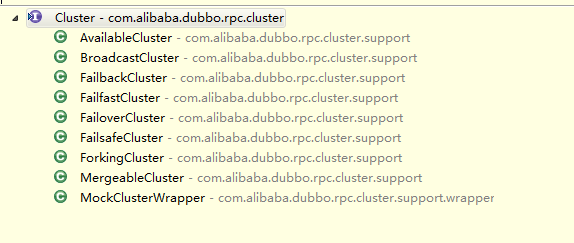
默认采用的是FailoverCluster,看下FailoverCluster:
- /**
- * 失败转移,当出现失败,重试其它服务器,通常用于读操作,但重试会带来更长延迟。
- *
- * <a href="http://en.wikipedia.org/wiki/Failover">Failover</a>
- *
- * @author william.liangf
- */
- public class FailoverCluster implements Cluster {
- public final static String NAME = "failover";
- public <T> Invoker<T> join(Directory<T> directory) throws RpcException {
- return new FailoverClusterInvoker<T>(directory);
- }
- }
- @SPI(RandomLoadBalance.NAME)
- public interface LoadBalance {
- /**
- * select one invoker in list.
- *
- * @param invokers invokers.
- * @param url refer url
- * @param invocation invocation.
- * @return selected invoker.
- */
- @Adaptive("loadbalance")
- <T> Invoker<T> select(List<Invoker<T>> invokers, URL url, Invocation invocation) throws RpcException;
- }

3.3 ProxyFactory
对于server端,ProxyFactory主要负责将服务如HelloServiceImpl统一进行包装成一个Invoker,这些Invoker通过反射来执行具体的HelloServiceImpl对象的方法。而对于client端,则是将上述创建的集群版Invoker创建出代理对象。接口定义如下:
- @Extension("javassist")
- public interface ProxyFactory {
- //针对client端,对Invoker对象创建出代理对象
- @Adaptive({Constants.PROXY_KEY})
- <T> T getProxy(Invoker<T> invoker) throws RpcException;
- //针对server端,将服务对象如HelloServiceImpl包装成一个Invoker对象
- @Adaptive({Constants.PROXY_KEY})
- <T> Invoker<T> getInvoker(T proxy, Class<T> type, URL url) throws RpcException;
- }
- public <T> T getProxy(Invoker<T> invoker, Class<?>[] interfaces) {
- return (T) Proxy.newProxyInstance(Thread.currentThread().getContextClassLoader(), interfaces, new InvokerInvocationHandler(invoker));
- }
- public class InvokerInvocationHandler implements InvocationHandler {
- private final Invoker<?> invoker;
- public InvokerInvocationHandler(Invoker<?> handler){
- this.invoker = handler;
- }
- public Object invoke(Object proxy, Method method, Object[] args) throws Throwable {
- String methodName = method.getName();
- Class<?>[] parameterTypes = method.getParameterTypes();
- if (method.getDeclaringClass() == Object.class) {
- return method.invoke(invoker, args);
- }
- if ("toString".equals(methodName) && parameterTypes.length == 0) {
- return invoker.toString();
- }
- if ("hashCode".equals(methodName) && parameterTypes.length == 0) {
- return invoker.hashCode();
- }
- if ("equals".equals(methodName) && parameterTypes.length == 1) {
- return invoker.equals(args[0]);
- }
- return invoker.invoke(new RpcInvocation(method, args)).recreate();
- }
- }
4. Dubbo中的通信模型
Dubbo支持Netty和Mina作为底层通信模型,其结构如下图所示:
Dubbo的Transporter层完成通信功能,底层的Netty和Mina委托给统一的ChannelHandler来完成具体的功能
4.1 服务端集成Netty
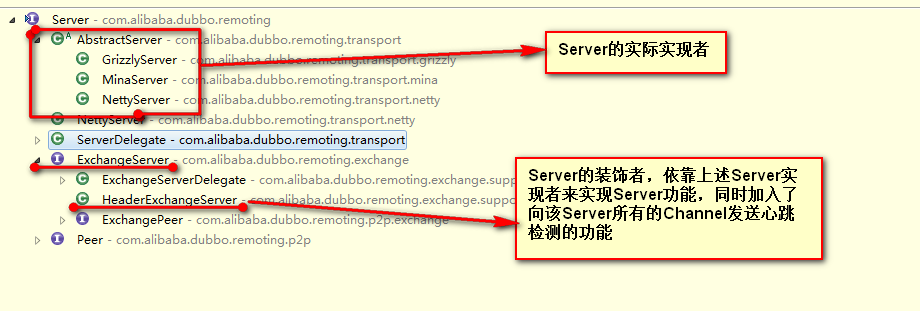
如NettyServer的启动流程: 按照netty自己的API启动方式,然后依据外界传递进来的com.alibaba.dubbo.remoting.ChannelHandler接口实现,创建出NettyHandler,最终对用户的连接请求的处理全部交给NettyHandler来处理,NettyHandler又交给了外界传递进来的com.alibaba.dubbo.remoting.ChannelHandler接口实现。至此就将所有底层不同的通信实现全部转化到了外界传递进来的com.alibaba.dubbo.remoting.ChannelHandler接口的实现上了。
而上述Server接口的另一个分支实现HeaderExchangeServer则充当一个装饰器的角色,为所有的Server实现增添了如下功能:
向该Server所有的Channel依次进行心跳检测:
- 1. 如果当前时间减去最后的读取时间大于heartbeat时间或者当前时间减去最后的写时间大于heartbeat时间,则向该Channel发送一次心跳检测
- 2. 如果当前时间减去最后的读取时间大于heartbeatTimeout,则服务器端要关闭该Channel,如果是客户端的话则进行重新连接(客户端也会使用这个心跳检测任务)
4.2 客户端集成Netty
服务器端了解了之后,客户端就也非常清楚了,整体类图如下:

如NettyClient在使用netty的API开启客户端之后,仍然使用NettyHandler来处理。还是最终转化成com.alibaba.dubbo.remoting.ChannelHandler接口实现上了。
HeaderExchangeClient和上面的HeaderExchangeServer非常类似,就不再提了。
我们可以看到这样集成完成之后,就完全屏蔽了底层通信细节,将逻辑全部交给了com.alibaba.dubbo.remoting.ChannelHandler接口的实现上了。从上面我们也可以看到,该接口实现也会经过层层装饰类的包装,才会最终交给底层通信。
如HeartbeatHandler装饰类:
- public void sent(Channel channel, Object message) throws RemotingException {
- setWriteTimestamp(channel);
- handler.sent(channel, message);
- }
- public void received(Channel channel, Object message) throws RemotingException {
- setReadTimestamp(channel);
- if (isHeartbeatRequest(message)) {
- Request req = (Request) message;
- if (req.isTwoWay()) {
- Response res = new Response(req.getId(), req.getVersion());
- res.setEvent(Response.HEARTBEAT_EVENT);
- channel.send(res);
- if (logger.isInfoEnabled()) {
- int heartbeat = channel.getUrl().getParameter(Constants.HEARTBEAT_KEY, 0);
- if(logger.isDebugEnabled()) {
- logger.debug("Received heartbeat from remote channel " + channel.getRemoteAddress()
- + ", cause: The channel has no data-transmission exceeds a heartbeat period"
- + (heartbeat > 0 ? ": " + heartbeat + "ms" : ""));
- }
- }
- }
- return;
- }
- if (isHeartbeatResponse(message)) {
- if (logger.isDebugEnabled()) {
- logger.debug(
- new StringBuilder(32)
- .append("Receive heartbeat response in thread ")
- .append(Thread.currentThread().getName())
- .toString());
- }
- return;
- }
- handler.received(channel, message);
- }
4.3 同步调用和异步调用的实现
使用netty mina等异步事件驱动的通信框架,将Channel中信息都分发到Handler中去处理了,Handler中的send方法只负责不断的发送消息,receive方法只负责不断接收消息,这时候就产生一个问题:
客户端如何对应同一个Channel的接收的消息和发送的消息之间的匹配呢?
这也很简单,就需要在发送消息的时候,必须要产生一个请求id,将调用的信息连同id一起发给服务器端,服务器端处理完毕后,再将响应信息和上述请求id一起发给客户端,这样的话客户端在接收到响应之后就可以根据id来判断是针对哪次请求的响应结果了。来看下DubboInvoker中的具体实现:
- boolean isAsync = RpcUtils.isAsync(getUrl(), invocation);
- boolean isOneway = RpcUtils.isOneway(getUrl(), invocation);
- int timeout = getUrl().getMethodParameter(methodName, Constants.TIMEOUT_KEY,Constants.DEFAULT_TIMEOUT);
- if (isOneway) {
- boolean isSent = getUrl().getMethodParameter(methodName, Constants.SENT_KEY, false);
- currentClient.send(inv, isSent);
- RpcContext.getContext().setFuture(null);
- return new RpcResult();
- } else if (isAsync) {
- ResponseFuture future = currentClient.request(inv, timeout) ;
- RpcContext.getContext().setFuture(new FutureAdapter<Object>(future));
- return new RpcResult();
- } else {
- RpcContext.getContext().setFuture(null);
- return (Result) currentClient.request(inv, timeout).get();
- }
- 如果不需要返回值,直接使用send方法,发送出去,设置当期和线程绑定RpcContext的future为null
- 如果需要异步通信,使用request方法构建一个ResponseFuture,然后设置到和线程绑定RpcContext中
- 如果需要同步通信,使用request方法构建一个ResponseFuture,阻塞等待请求完成
- String result1 = helloService.hello("World");
- System.out.println("result :"+result1);
- System.out.println("result : "+RpcContext.getContext().getFuture().get());
然后我们来看下异步请求的整个实现过程,即上述currentClient.request方法的具体内容:
- public ResponseFuture request(Object request, int timeout) throws RemotingException {
- // create request.
- Request req = new Request();
- req.setVersion("2.0.0");
- req.setTwoWay(true);
- req.setData(request);
- DefaultFuture future = new DefaultFuture(channel, req, timeout);
- try{
- channel.send(req);
- }catch (RemotingException e) {
- future.cancel();
- throw e;
- }
- return future;
- }
- public class Request {
- private final long mId;
- private static final AtomicLong INVOKE_ID = new AtomicLong(0);
- public Request() {
- mId = newId();
- }
- private static long newId() {
- // getAndIncrement()增长到MAX_VALUE时,再增长会变为MIN_VALUE,负数也可以做为ID
- return INVOKE_ID.getAndIncrement();
- }
- }
- private static final Map<Long, DefaultFuture> FUTURES = new ConcurrentHashMap<Long, DefaultFuture>();
第三步:将上述请求对象发送给服务器端,同时将DefaultFuture对象返给上一层函数,即 DubboInvoker中,然后设置到当前线程中
第四步:用户通过 RpcContext来获取上述 DefaultFuture对象来获取请求结果,会 阻塞至服务器端返产生结果给客户端
第五步:服务器端产生结果,返回给客户端会在客户端的handler的receive方法中接收到,接收到之后判别接收的信息是 Response后,
- static void handleResponse(Channel channel, Response response) throws RemotingException {
- if (response != null && !response.isHeartbeat()) {
- DefaultFuture.received(channel, response);
- }
- }
- String result1 = helloService.hello("World");
- String result2 = helloService.hello("java");
- System.out.println("result :"+result1);
- System.out.println("result :"+result2);
- System.out.println("result : "+RpcContext.getContext().getFuture().get());
- System.out.println("result : "+RpcContext.getContext().getFuture().get());
- String result1 = helloService.hello("World");
- Future<String> result1Future=RpcContext.getContext().getFuture();
- String result2 = helloService.hello("java");
- Future<String> result2Future=RpcContext.getContext().getFuture();
- System.out.println("result :"+result1);
- System.out.println("result :"+result2);
- System.out.println("result : "+result1Future.get());
- System.out.println("result : "+result2Future.get());
package com.alibaba.xxx;
import com.alibaba.dubbo.rpc.Protocol;
public class XxxProtocolWrapper implemenets Protocol {
Protocol impl;
public XxxProtocol(Protocol protocol) { impl = protocol; }
// 接口方法做一个操作后,再调用extension的方法
public Exporter<T> export(final Invoker<T> invoker) {
//... 一些操作
impl .export(invoker);
// ... 一些操作
}
// ...
}
package com.alibaba.xxx;
import com.alibaba.dubbo.rpc.Protocol;
public class XxxProtocolWrapper implemenets Protocol {
Protocol impl;
public XxxProtocol(Protocol protocol) { impl = protocol; }
// 接口方法做一个操作后,再调用extension的方法
public Exporter<T> export(final Invoker<T> invoker) {
//... 一些操作
impl .export(invoker);
// ... 一些操作
}
// ...
}
private ExchangeHandler requestHandler = new ExchangeHandlerAdapter() {
public Object reply(ExchangeChannel channel, Object message) throws RemotingException {
if (message instanceof Invocation) {
Invocation inv = (Invocation) message;
Invoker<?> invoker = getInvoker(channel, inv);
RpcContext.getContext().setRemoteAddress(channel.getRemoteAddress());
return invoker.invoke(inv);
}
throw new RemotingException(channel, "Unsupported request: " + message == null ? null : (message.getClass().getName() + ": " + message) + ", channel: consumer: " + channel.getRemoteAddress() + " --> provider: " + channel.getLocalAddress());
}
};
public interface Invocation {
URL getUrl();
String getMethodName();
Class<?>[] getParameterTypes();
Object[] getArguments();
}
public interface Invocation {
URL getUrl();
String getMethodName();
Class<?>[] getParameterTypes();
Object[] getArguments();
}
